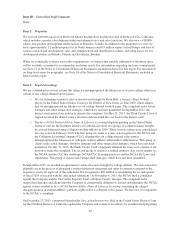Electronic Arts 2014 Annual Report Download - page 99
Download and view the complete annual report
Please find page 99 of the 2014 Electronic Arts annual report below. You can navigate through the pages in the report by either clicking on the pages listed below, or by using the keyword search tool below to find specific information within the annual report.
Annual Report
CRITICAL ACCOUNTING POLICIES AND ESTIMATES
Our Consolidated Financial Statements have been prepared in accordance with accounting principles generally
accepted in the United States (“U.S. GAAP”). The preparation of these Consolidated Financial Statements
requires management to make estimates and assumptions that affect the reported amounts of assets and liabilities,
contingent assets and liabilities, and revenue and expenses during the reporting periods. The policies discussed
below are considered by management to be critical because they are not only important to the portrayal of our
financial condition and results of operations, but also because application and interpretation of these policies
requires both management judgment and estimates of matters that are inherently uncertain and unknown. As a
result, actual results may differ materially from our estimates.
Revenue Recognition, Sales Returns and Allowances, and Bad Debt Reserves
We derive revenue principally from sales of interactive software games, and related content and services on
(1) video game consoles (such as Playstation 3 and 4 from Sony and Xbox 360 and Xbox One from Microsoft)
and PCs, and (2) mobile phones and tablets. We evaluate revenue recognition based on the criteria set forth in
FASB Accounting Standards Codification (“ASC”) 605, Revenue Recognition and ASC 985-605, Software:
Revenue Recognition. We classify our revenue as either product revenue or service and other revenue.
Product revenue. Our product revenue includes revenue associated with the sale of software games or related
content, whether delivered via a physical disc (e.g., packaged goods) or delivered digitally via the Internet (e.g.,
full-game downloads, micro-transactions), and licensing of game software to third-parties. Product revenue also
includes revenue from mobile full game downloads that do not require our hosting support, and sales of tangible
products such as hardware, peripherals, or collectors’ items.
Service and other revenue. Our service revenue includes revenue recognized from time-based subscriptions
and games or related content that requires our hosting support in order to utilize the game or related content (i.e.,
can only be played with an Internet connection). This includes (1) entitlements to content that are accessed
through hosting services (e.g., micro-transactions for Internet-based, social network and mobile games),
(2) massively multi-player online (“MMO”) games (both software game and subscription sales), (3) subscriptions
for our Battlefield Premium and Pogo-branded online game services, and (4) allocated service revenue from sales
of software games with an online service element (i.e., “matchmaking” service). Our other revenue includes
advertising and non-software licensing revenue.
With respect to the allocated service revenue from sales of software games with a matchmaking service mentioned
above, our allocation of proceeds between product and service revenue for presentation purposes is based on
management’s best estimate of the selling price of the matchmaking service with the residual value allocated to
product revenue. Our estimate of the selling price of the matchmaking service is comprised of several factors
including, but not limited to, prior selling prices for the matchmaking service, prices charged separately by other
third-party vendors for similar service offerings, and a cost-plus-margin approach. We review the estimated selling
price of the online matchmaking service on a regular basis and use this methodology consistently to allocate
revenue between product and service for software game sales with a matchmaking service.
We evaluate and recognize revenue when all four of the following criteria are met:
•Evidence of an arrangement. Evidence of an agreement with the customer that reflects the terms and
conditions to deliver the related products or services must be present.
•Fixed or determinable fee. If a portion of the arrangement fee is not fixed or determinable, we
recognize revenue as the amount becomes fixed or determinable.
•Collection is deemed probable. Collection is deemed probable if we expect the customer to be able to
pay amounts under the arrangement as those amounts become due. If we determine that collection is
not probable as the amounts become due, we generally conclude that collection becomes probable upon
cash collection.
•Delivery. Delivery is considered to occur when a product is shipped and the risk of loss and rewards of
ownership have transferred to the customer. For digital downloads, delivery is considered to occur
29
























